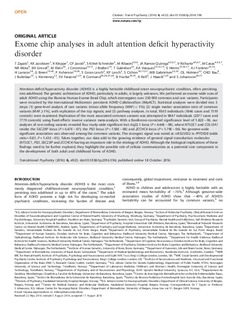| dc.contributor.author | Zayats, Tetyana | |
| dc.contributor.author | Jacobsen, Kaya Kvarme | |
| dc.contributor.author | Kleppe, Rune | |
| dc.contributor.author | Jacob, CP | |
| dc.contributor.author | Kittel-Schneider, Sarah | |
| dc.contributor.author | Ribases, Marta | |
| dc.contributor.author | Ramos-Quiroga, JA | |
| dc.contributor.author | Richarte, Vanesa | |
| dc.contributor.author | Casas, M | |
| dc.contributor.author | Mota, NR | |
| dc.contributor.author | Grevet, EH | |
| dc.contributor.author | Klein, M | |
| dc.contributor.author | Corominas, J | |
| dc.contributor.author | Bralten, Janita | |
| dc.contributor.author | Galesloot, T | |
| dc.contributor.author | Vasquez, AA | |
| dc.contributor.author | Herms, S | |
| dc.contributor.author | Forstner, AJ | |
| dc.contributor.author | Larsson, H | |
| dc.contributor.author | Breen, G | |
| dc.contributor.author | Asherson, P | |
| dc.contributor.author | Gross-Lesch, Silke | |
| dc.contributor.author | Lesch, KP | |
| dc.contributor.author | Cichon, Sven | |
| dc.contributor.author | Gabrielsen, Maiken Elvestad | |
| dc.contributor.author | Holmen, Oddgeir Lingaas | |
| dc.contributor.author | Bau, CH | |
| dc.contributor.author | Buitelaar, Jan | |
| dc.contributor.author | Kiemeney, L | |
| dc.contributor.author | Faraone, Stephen V. | |
| dc.contributor.author | Cormand, B | |
| dc.contributor.author | Franke, Barbara | |
| dc.contributor.author | Reif, Andreas | |
| dc.contributor.author | Haavik, Jan | |
| dc.contributor.author | Johansson, Stefan | |
| dc.date.accessioned | 2017-05-11T07:18:44Z | |
| dc.date.available | 2017-05-11T07:18:44Z | |
| dc.date.created | 2017-01-10T09:56:57Z | |
| dc.date.issued | 2016 | |
| dc.identifier.citation | Translational psychiatry. 2016, 6 (e923), . | nb_NO |
| dc.identifier.issn | 2158-3188 | |
| dc.identifier.uri | http://hdl.handle.net/11250/2442216 | |
| dc.description.abstract | Attention-deficit/hyperactivity disorder (ADHD) is a highly heritable childhood-onset neuropsychiatric condition, often persisting into adulthood. The genetic architecture of ADHD, particularly in adults, is largely unknown. We performed an exome-wide scan of adult ADHD using the Illumina Human Exome Bead Chip, which interrogates over 250 000 common and rare variants. Participants were recruited by the International Multicenter persistent ADHD CollaboraTion (IMpACT). Statistical analyses were divided into 3 steps: (1) gene-level analysis of rare variants (minor allele frequency (MAF)<1%); (2) single marker association tests of common variants (MAFgreater than or equal to1%), with replication of the top signals; and (3) pathway analyses. In total, 9365 individuals (1846 cases and 7519 controls) were examined. Replication of the most associated common variants was attempted in 9847 individuals (2077 cases and 7770 controls) using fixed-effects inverse variance meta-analysis. With a Bonferroni-corrected significance level of 1.82E−06, our analyses of rare coding variants revealed four study-wide significant loci: 6q22.1 locus (P=4.46E−08), where NT5DC1 and COL10A1 reside; the SEC23IP locus (P=6.47E−07); the PSD locus (P=7.58E−08) and ZCCHC4 locus (P=1.79E−06). No genome-wide significant association was observed among the common variants. The strongest signal was noted at rs9325032 in PPP2R2B (odds ratio=0.81, P=1.61E−05). Taken together, our data add to the growing evidence of general signal transduction molecules (NT5DC1, PSD, SEC23IP and ZCCHC4) having an important role in the etiology of ADHD. Although the biological implications of these findings need to be further explored, they highlight the possible role of cellular communication as a potential core component in the development of both adult and childhood forms of ADHD. | nb_NO |
| dc.language.iso | eng | nb_NO |
| dc.relation.uri | http://www.nature.com/tp/journal/v6/n10/pdf/tp2016196a.pdf | |
| dc.rights | Navngivelse 4.0 Internasjonal | * |
| dc.rights.uri | http://creativecommons.org/licenses/by/4.0/deed.no | * |
| dc.title | Exome chip analyses in adult attention deficit hyperactivity disorder | nb_NO |
| dc.type | Journal article | nb_NO |
| dc.type | Peer reviewed | nb_NO |
| dc.description.version | publishedVersion | nb_NO |
| dc.source.pagenumber | 7 | nb_NO |
| dc.source.volume | 6 | nb_NO |
| dc.source.journal | Translational psychiatry | nb_NO |
| dc.source.issue | e923 | nb_NO |
| dc.identifier.doi | 10.1038/tp.2016.196 | |
| dc.identifier.cristin | 1423938 | |
| dc.description.localcode | This work is licensed under a Creative Commons Attribution 4.0 International License. The images or other third party material in this article are included in the article’s Creative Commons license, unless indicated otherwise in the credit line; if the material is not included under the Creative Commons license, users will need to obtain permission from the license holder to reproduce the material. To view a copy of this license, visit http://creativecommons.org/licenses/by/4.0/. | nb_NO |
| cristin.unitcode | 194,65,20,0 | |
| cristin.unitcode | 194,65,10,0 | |
| cristin.unitname | Institutt for samfunnsmedisin | |
| cristin.unitname | Institutt for laboratoriemedisin, barne- og kvinnesykdommer | |
| cristin.ispublished | true | |
| cristin.fulltext | original | |
| cristin.qualitycode | 1 | |

